List of Subaru engines
Subaru uses a four or five character code to identify all of their engines.[1]
- The first letter is always E standing for engine (before the introduction of FB engine series)
- The second letter is the engine's family.
- Next come two digits indicating the engine's displacement (or revision before 1989)
- The optional fifth character is an identifier to mark revisions, (ex: turbo, DOHC, Fuel Injection, etc.)
Two Cylinder
Subaru EK engine
The EK series was a straight twin two-stroke cycle with early air-cooled versions later replaced with water-cooled configurations in 1971. The engine was upgraded to a four-stroke SOHC in 1973 to meet Japanese Government emission regulations.
The (Japanese: Subaru EK series) was used from 1958 until 1989 in most Kei car models.
Two-strokes
Air Cooled two-stroke

- EK31: 356 cc Bore & Stroke = 61.5 x 60 mm
- maximum output 16 PS (12 kW; 16 hp) at 4,500 rpm (1958.05-1960.02)
- maximum output 18 PS (13 kW; 18 hp) at 4,700 rpm (1960.02-1964.07)
- maximum output 20 PS (15 kW; 20 hp) at 5,000 rpm (1964.07-1968.08)
- compression ratio = 6.5:1
Used in the Subaru 360 (1958–1968) and Sambar (1961–1970).
- EK51: 423 cc Bore & Stroke = 67.0 x 60.0 mm
- maximum output 23 PS (17 kW; 23 hp) at 5,000 rpm
- compression ratio = 6.5:1
Used in the Subaru 450 (MAIA) Japan & North America (1960–66)
- EK32: 356 cc Bore & Stroke = 61.5 x 60 mm
- maximum output 25 PS (18 kW; 25 hp) at 5,500 rpm (1968.08-1970)
- maximum output 36 PS (26 kW; 36 hp) at 7,000 rpm (1968.11-1970)
- compression ratio = 7.5:1
- Used in the Subaru 360 and 360 Young SS, 1968-70.
- EK33: 356 cc Bore & Stroke = 61.5 x 60 mm
- compression ratio = 6.5:1 (standard) 7.5:1 (Young SS & Sport Edition)
- maximum output 26 PS (19 kW; 26 hp) at 5,800 rpm (R-2 Van K41, Sambar K55/K64)
- maximum output 30 PS (22 kW; 30 hp) at 6,500 rpm (R-2)
- maximum output 36 PS (26 kW; 36 hp) at 7,000 rpm (R-2 SS)
- maximum output 32 PS (24 kW; 32 hp) at 6,500 rpm (R-2 Sport Edition)
Used in the Subaru R-2 1969–1971 and Subaru Sambar 1970–1973
Water Cooled Two-stroke cycle
- EK34: 356 cc Bore & Stroke = 61.5 x 60.0 mm
- compression ratio = 6.5:1
- maximum output 28 PS (21 kW; 28 hp) at 5,500 rpm (Sambar K71/K72/K81)
- maximum output 32 PS (24 kW; 32 hp) at 6,000 rpm (R-2, Rex)
- maximum output 35 PS (26 kW; 35 hp) at 6,500 rpm (Rex TS)
- maximum output 36 PS (26 kW; 36 hp) at 7,000 rpm (R-2 GSS)
- maximum output 37 PS (27 kW; 36 hp) at 6,500 rpm (Rex GSR)
Used in the Subaru R-2 1971.10-1972.07, Subaru Rex 1972.07-1973.10, Subaru Sambar 1973.02-1976.02
Four-strokes
Water Cooled four-stroke SOHC with SEEC emissions system (later SEEC-T), alloy block and head.[2]
- EK21: Bore x Stroke mm = 66.0 x 52.4
- Piston displacement = 358 cc
- Compression ratio = 9.5:1
- maximum output 28 PS (21 kW; 28 hp) at 7,500 rpm (Rex Van K42, Wagon K26, Rex sedan 75.12-76.05)
- maximum output 31 PS (23 kW; 31 hp) at 8,000 rpm (73.10-75.12 Rex)
Used in the Subaru Rex K22 from 1973.10–1976.05, Subaru Sambar February 1976-May 1976
- EK22: Bore x Stroke mm = 74.0 x 57.0, SEEC-T emissions system
- Piston displacement = 490 cc
- Compression ratio = 9.0:1
- maximum output 28 PS (21 kW; 28 hp) (Rex 5 Van K43, Sambar 5 K75/76/85)
- maximum output 31 PS (23 kW; 31 hp) at 6,500 rpm (Rex 5 K23)
Used in the Subaru Rex 1976.05–1977.05, Subaru Sambar 5 from May 1976 until March 1977
- EK23: Bore x Stroke mm = 76.0 x 60.0
- Piston displacement = 544 cc
- Compression ratio = 8.5:1
- Two valves per cylinder
- maximum output 31 PS (23 kW; 31 hp) at 6,200 rpm (Rex)
- maximum output 28 PS (21 kW; 28 hp) at 6,200 rpm (Rex Van, Sambar)
- maximum output 31 PS (23 kW; 31 hp) at 6,000 rpm (Rex 2nd gen & Rex Combi)
- maximum output 30 PS (22 kW; 30 hp) at 6,000 rpm (Rex 3rd gen)
Used in the Subaru Rex from 1977.05–1989, Subaru Sambar 1977–1990
- EK23 ThreeValve: Bore x Stroke mm = 76.0 x 60.0
- Piston displacement = 544 cc
- Compression ratio = 9.0:1
- Two valves per cylinder
- maximum output 34 PS (25 kW; 34 hp) at 6,000 rpm (Sambar)
- maximum output 36 PS (26 kW; 36 hp) at 7,000 rpm (Rex)
Used in the Subaru Rex Viki from 1986 to 1989, Subaru Sambar 1989–1990
- EK23 Turbo Bore x Stroke mm = 76.0 x 60.0
- Piston displacement = 544 cc
- Compression ratio = 8.5:1
- Two valves per cylinder
- Hitachi-made 36 mm turbines
- maximum output 41 PS (30 kW; 40 hp) at 6,000 rpm
Used in the Subaru Rex Combi (1983–1986)
- EK23 ThreeValve Turbo Bore x Stroke mm = 76.0 x 60.0
- Piston displacement = 544 cc
- Compression ratio = 9.0:1
- Three valves per cylinder (two intake, one exhaust)
- Hitachi-made 36 mm turbines
- maximum output 36 PS (26 kW; 36 hp) at 7000 rpm
Used in the Subaru Rex VX (1986–1989)
- EK23 ThreeValve Supercharger Bore x Stroke mm = 76.0 x 60.0
- Piston displacement = 544 cc
- Compression ratio = 9.0:1
- Three valves per cylinder (two intake, one exhaust)
- Water-cooled intercooler
- maximum output 55 PS (40 kW; 54 hp) at 6400 rpm
Used in the Subaru Rex Supercharger (1988–1989)
- EK42 Bore x Stroke mm = 78.0 x 69.6
- Piston displacement = 665 cc
- Compression ratio = 9.5:1
- Two valves per cylinder
- maximum output 31 PS (23 kW; 31 hp) (Subaru 700)
- maximum output 37 PS (27 kW; 36 hp) at 6400 rpm, low octane version
- maximum output 35 PS (26 kW; 35 hp) at 6400 rpm (M70, Mini Jumbo, Sherpa), high octane version
Used in the Subaru Rex and Sambar/700 (export only, 1982–1989)
Three Cylinder
The EF series engine is a liquid-cooled three-cylinder, four-stroke, with SOHC. It is not compliant with Japanese Government regulations concerning displacement of kei cars with a current maximum limit of 660 cc. The EF appeared while the EK was being replaced by the EN05.
Subaru EF engine
- EF10: Bore x Stroke mm = 78.0 x 69.6
- Piston displacement = 997 cc
- Compression ratio = 9.5:1
- Two valves per cylinder
SOHC 2V, 55 hp at 5,200 rpm 1984–1987 Subaru Justy
- EF12:Bore x Stroke mm = 78.0 x 83.0
- Piston displacement = 1189 cc
- Compression ratio = 9.1:1
- Three valves per cylinder
SOHC 3V, 66-73 hp 1987–1994 Subaru Justy
Four Cylinder
All of Subaru's four-cylinder engines (except the EN series) are liquid-cooled, horizontally opposed boxer four-strokes.
Subaru EA engine
The EA was used from 1966 until 1994 in most models. It is a basic two-valve-per-cylinder design with siamese ports and three main crankshaft bearings. Engines with overhead camshafts were installed with two timing belts, whereas vehicles with overhead valves used timing gears exclusively.
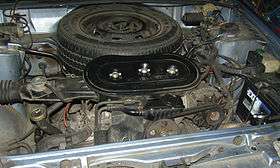
- EA52: 977 cc OHV, 55 hp at 6,000 rpm used in the 1966–1971 Subaru 1000
- EA61: 1088.8 cc OHV, 62 hp at 6,400 rpm used in the 1970–1972 Subaru FF-1 Star and Subaru G
- EA62: 1267.5 cc OHV, 80 hp at 6,400 rpm used in the 1971–1972 Subaru G
- EA63: 1362 cc OHV, 58 hp at 5,200 rpm used in the 1973–1976 Subaru Leone
- EA71: 1595 cc OHV, 67 hp at 5,200 rpm or 68 at 4,800 rpm used in the 1976–1987 Subaru Leone and 1978–1980 Subaru BRAT/brumby
- EA81: 1781 cc OHV, 73 hp at 4,800 rpm used in the 1980–1984 Subaru Leone and 1981–1993 Subaru BRAT/brumby
- EA81T: 1781 cc OHV Turbo, 95 hp at 4,200 rpm used in the 1983–1984 Subaru Leone and Subaru BRAT/brumby
- EA82: 1791 cc SOHC, 84-97 hp used in the Subaru Leone and Subaru XT
- EA82T: 1791 cc SOHC, 136 hp at 5200 rpm used in the Subaru Leone and Subaru XT
Subaru EE engine (diesel)
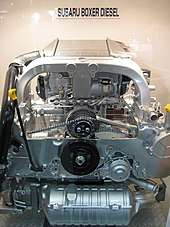
Subaru unveiled the world's first boxer diesel engine to be fitted in a passenger car at the Geneva Auto Show in 2007.[3] This 2.0L DOHC engine, designated the EE20,[4] has an output of 110 kW (150 PS; 148 bhp) at 3600 rpm and develops 350 N⋅m (260 lb⋅ft) of torque at 1,600 RPM,[5][6] with a redline of 4750 rpm.[7] The engine has a total displacement of 1,998 cc (122 cu in) from a square 86 mm × 86 mm (3.4 in × 3.4 in) bore x stroke with a compression ratio of 16.3:1 and uses five main bearings. The EE20 shares a bore pitch dimension and assembly line with the EZ30 at the Ooizumi Factory; compared to the contemporaneous gasoline EJ20, which has a similar displacement, the EE20 is 61.3 mm (2.41 in) shorter.[5]
The common rail solenoid injector is manufactured by Denso and operates at 180 MPa (26,000 psi).[5] The IHI variable geometry turbo is mounted under the right side of the engine, close to the exhaust manifold, reducing turbo lag.[7][5] For the Legacy 2.0D, Subaru claimed consumption improved by 15 to 20% (ranging between 5.6 and 6.4 l/100 km (42 and 37 mpg‑US)) and that CO2 emissions fell from 196 to 148 g/km (0.70 to 0.53 lb/mi) compared to the similar model with a gasoline engine.[7][8]
Fuji Heavy Industries (FHI) spent three years starting in fall 2005 developing the EE20 after concluding the marque needed a diesel engine to compete in Europe.[8] Details about the engine were first released in February 2008,[5] after an additional preview at Frankfurt in 2007,[9] and an official announcement of applications was made at Geneva in March 2008.[10][11]
The EE20 was originally released with Euro-4 emissions compliance; an oxidation catalyst and diesel particulate filter are mounted close to the turbo, using heat from exhaust gases, and the exhaust gas recirculation system is water-cooled to meet regulations.[5] The compliance was soon updated to Euro-5[12] and Euro-6 in 2015.
- Availability
Per the March 2008 announcement at Geneva, the EE20 was sold in Legacy (wagon and sedan) and Outback vehicles for the European market; the diesel was only offered with a manual transmission at first, and the clutch and flywheel were specifically modified for diesel use.[5] In September 2008, FHI announced the EE20 would be available as a slightly modified variant (the diesel particulate filter was now closed) in Forester and Impreza models sold in Europe starting that fall. For the Forester, output was reduced slightly to 108 kW (147 PS; 145 bhp).[13]
The EE20 was offered with the Impreza XV at that model's launch in 2010.[14] The Subaru continuously variable transmission (branded Lineartronic) was offered as an option for EE20-equipped Outback models starting in 2013,[15] and sales of the Lineartronic EE20 Outback would start in Australia later in 2013.[16] At Geneva 2013, the diesel boxer was combined with three electric motors to form the hybrid powertrain of the Subaru VIZIV Concept.[17] The Lineartronic EE20 powertrain was added to the Forester in 2015.[18]
In 2016, citing increasingly stringent emissions standards, the project manager for the Impreza stated that further development of the EE20 had been halted.[19] In September 2017, Subaru announced production of diesel automobiles would end by 2020; at the time, sales were approximately 15,000 diesel-powered cars annually in Europe and Australia. The capacity gained would be used to start producing plug-in hybrids in 2018 and electric vehicles by 2021.[20] At Geneva in March 2018, Subaru UK confirmed its parent company's plans to discontinue diesel production, but had enough stock on hand to meet projected demand through the end of 2018.[21]
Subaru EJ engine
The EJ engine was introduced in the 1989 Subaru Legacy to replace the EA engines. It was designed from scratch with five main crankshaft bearings and four valves per cylinder and can be either SOHC or DOHC and one timing belt. The fifth digit is the only way to tell without seeing the engine.
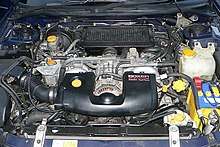
- EJ15: 1483.4 cc SOHC, 1990–2003 JDM Subaru Impreza
- EJ16: 90 hp at 5,600 rpm used in the 1993–2006 Subaru Impreza
- EJ18: 1820 cc SOHC 110 hp at 5,600 rpm used in the 1993–1996 Subaru Impreza and Euro and JDM Subaru Legacy
- EJ20: 1994.3 cc, available in Australia, Europe and Japan naturally aspirated at 115–190 hp and with a Turbo 220–280 hp used on Most Models, (2002–2005 WRX in the United States)
- EJ22: 2212 cc, 135–280 hp used in the 1989–2001 Subaru Impreza and Subaru Legacy
- EJ25: 2457 cc, 165–320 hp found in Most Models 1995–Present
- EJ30: Special limited engine. Four were built by Subaru, but only 3 remain in working condition. There is no readily available technical or power information on these engines.
Generally the EJ-series can be divided into two versions: the Phase I engines (1989–1998) and the Phase II engines (1999–2010). The Phase II engines featured new cylinder heads and crankshafts with the thrust bearing located at crank bearing #5 instead of #3. The designation also changed from Phase I to Phase II. All Phase I engines have an alphanumerical suffix behind the standard EJXX designation, all Phase II engines have a numerical suffix behind the EJXX designation. Example:
Phase I: EJ15E, EJ15J, EJ16E, EJ18E, EJ20D, EJ20E, EJ20G, EJ20H, EJ20J, EJ20R, EJ20K, EJ22E, EJ221, EJ25D
Phase II: EJ151, EJ161, EJ181, EJ201, EJ202, EJ203, EJ204, EJ205, EJ206, EJ207, EJ208, EJ222, EJ251, EJ252, EJ253, EJ254, EJ255, EJ257
- There's at least 1 exception from this rule - MY'07 EJ20F engine. Most likely F stands for bi-Fuel (engines prepared for LPG). This engine model has reinforced engine valves. This is unconfirmed info, based only on users' experience and observations.
Subaru EL engine
The (Japanese: Subaru EL engine) replaced the EJ15 and is used in the JDM Subaru Impreza 1.5R (series GD, GG, GE, GH) starting with model year 2006. It is based on the EJ engine and shares many components, like the crankshaft from the EJ25. It has DOHC cylinder heads with AVCS variable valve timing on the intake.[22][23]
- Displacement: 1,498 cc
- bore x stroke: 77.7 x 79 mm
- compression ratio: 10.1
- maximum horsepower: 110ps (81 kW) at 6,400 RPM
- maximum torque: 14.7kgm (144Nm) at 3,200 rpm
- AVCS
Subaru EN engine
The Subaru EN inline-four engine was introduced in 1988 to replace the straight-two EK series engine that was originally engineered as an air-cooled engine and then was modified as a water-cooled engine used in the 1969–1972 Subaru R-2. The EN is used in all kei cars and kei trucks currently in production by Subaru.
Subaru FA engine
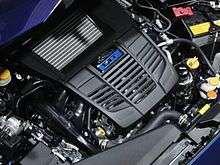
(Japanese: Subaru FA engine) The FA was developed from the FB engine, however, efforts to reduce weight while maintaining durability were the main goals of the FA engine. While the FA and FB engines share a common platform, the FA shares very little in dedicated parts with the FB engine, with a different block, head, connecting rods, and pistons.[24]
- FA20D: 1998 cc DOHC, aka Toyota 4U-GSE; 2013+ Subaru BRZ/Toyota 86
- FA20F: 1998 cc DOHC, turbo, 2012+ JDM Subaru Legacy 2.0GT DIT and 2014+ Subaru Levorg; 2014+ USDM and JDM Subaru Forester XT; 2015+ USDM Subaru WRX
- FA24F: 2,387 cc DOHC, turbo, 2019+ USDM Subaru Ascent, 2020+ Subaru Legacy, and 2020+ Subaru Outback
Subaru FB engine
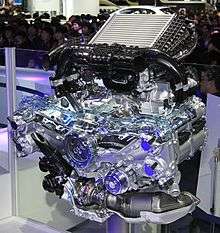
The FB-series (initially available as naturally-aspirated engines in 2.5 and 2.0 litre displacements) is the first new generation of boxer engine since the EJ-series. Subaru announced details of the FB engine on 23 September 2010.[25] By increasing piston stroke and decreasing piston bore, Subaru aimed to reduce emissions and improve fuel economy, while increasing and broadening torque output over the previous generation engine.
The FB has an all new block and head featuring dual overhead cams with intake and exhaust variable valve timing (AVCS - Active Valve Control System), and a timing chain that replaced the timing belt. Moving to chain-driven cams allows the valves to be placed at a more narrow angle to each other and shrinks the cylinder bore from 99.5 mm to 94. It results in less unburned fuel during cold start, thereby reducing emissions. Subaru also uses asymmetrical connecting rods like those in EZ36. The FB is only marginally heavier and has similar exterior dimensions compared to an EJ engine of equivalent displacement. In Jan 2011, Car and Driver was told direct injection would be added soon.[26] In 2019, Direct Injection was added to FB engines used in the 2019 Forester, the 2020 Legacy, and the 2020 Outback.
Subaru claims a 28-percent reduction in friction losses, mainly due to lighter pistons and connecting rods.[26][27] The FB has a 10% improvement in fuel economy with the power coming on sooner and the torque band being broader.
- FB16E: 1597 cc DOHC, 2012+ EUDM Subaru Impreza XV 1.6i
- FB16F: 1599 cc DOHC, turbo, 2014+ Subaru Levorg
- FB20B: 1995 cc DOHC, 2011+ JDM Subaru Forester, 2012-2016 Subaru Impreza, and 2012-2017 Subaru XV
- FB20D: 1995 cc DOHC, 2017+ Subaru Impreza, and 2018+ Subaru XV
- FB20X: 1995 cc DOHC, 2014–16 Subaru XV Hybrid
- FB20V: 1995 cc DOHC, 2019+ Subaru XV Hybrid
- FB25B: 2498 cc DOHC, 2011–18 North American Subaru Forester, 2012-2019 North American Subaru Legacy, and 2012-2019 North American Subaru Outback
- FB25D: 2498 cc DOHC, 2019+ North American Subaru Forester, 2020+ North American Subaru Legacy, and 2020+ North American Subaru Outback
Six Cylinder
All of Subaru's six-cylinder engines are of a liquid-cooled, Flat-6 four-stroke design.
Subaru ER engine
(Japanese: Subaru ER27) Subaru introduced its first six-cylinder engine in its Subaru XT sports car. This MPI SOHC 2-Valve engine was based on the EA82, with two cylinders added to the front.
Subaru EG engine
The (Japanese: Subaru EG33) engine was a direct replacement for the ER engine. The ER had been used only in the Subaru XT6, which was being replaced by the Subaru Alcyone SVX, and the company took the opportunity to create a new engine based on the more modern EJ rather than the EA engine series. As the ER27 was to the EA82, Subaru took the EJ22 design and created a six-cylinder version to make the new EG33. However, this four-valves-per-cylinder engine was DOHC, and valvetrain parts came from the not yet released EJ25D. Bore: 96.9 mm Stroke: 75 mm
- EG33: 3318 cc DOHC, 230 hp at 5,400 rpm used in the 1992–1997 Subaru Alcyone SVX
Subaru EZ engine

The (Japanese: Subaru EZ series) was introduced in 1999 in the Japanese market, in the Subaru Outback, and in 2000 in the United States market, also in the Outback. It is a flat-six, 24-valve, quad-cam engine with an aluminium block and heads. It is available in EZ30 and EZ36 variants. Though the second iteration of the EZ30D used from 2003 to 2009 was heavily updated from the early EZ30D used from 2001 to 2003, Subaru continued to identify it as EZ30D. "EZ30R" is a false engine code often used on the Internet for the later EZ30, but Subaru has never used it as an official engine code.[28] All EZ-series engines use dual timing chains and feature coil-on-plug ignition.
The 2000-2003 EZ30D used one exhaust port per head, a cable-actuated throttle, variable intake geometry, and a cast aluminium intake manifold. It was only available with an automatic transmission.
- Displacement: 2999 cc DOHC
- Bore: 89.2 mm
- Stroke: 80 mm
- Compression: 10.7:1
- Power: 220 PS (162 kW; 217 hp) at 6000 rpm
- Torque: 289 N⋅m (29 kg⋅m; 213 lb⋅ft) at 4400 rpm
- Application:
- 2000–2004 Subaru Outback H6
- 2002-2003 Subaru Legacy GT30
- 2000–2003 Subaru Legacy Lancaster 6
- 2002-2003 Subaru Legacy RS30[29]
The 2003-2007 EZ30D received new cylinder heads with 3 exhaust ports per head, AVLS, AVCS on the intake cams only, a drive-by-wire throttle, and a plastic intake manifold. It was available in manual and automatic unlike the original EZ30D.
- Displacement: 2999 cc DOHC
- Bore: 89.2 mm
- Stroke: 80 mm
- Compression: 10.7:1
- Power: 245 PS (180 kW; 242 hp) at 6600 rpm
- Torque: 297 N⋅m (30 kg⋅m; 219 lb⋅ft) at 4200 rpm
- Application:
- 2003–2009 Subaru Legacy 3.0R
- 2005–2009 Subaru Outback 3.0R
- 2006–2007 Tribeca
The EZ36D retains the plastic intake manifold, 3 exhaust ports per head, and drive-by-wire throttle of the later EZ30D, but loses AVLS while gaining AVCS for both intake and exhaust cams. The EZ36D also incorporates an asymmetrical connecting rod design shared with the FB series of engines and the EE20 diesel engine.
- Displacement: 3629 cc DOHC
- Bore: 92 mm
- Stroke: 91 mm
- Compression: 10.5:1
- Power: 260 PS (191 kW; 256 hp) at 6000 rpm
- Torque: 350 N⋅m (36 kg⋅m; 258 lb⋅ft) at 4400 rpm
- Application:
- 2010-2019 Subaru Legacy
- 2010-2019 Subaru Outback
- 2008-2014 Subaru Tribeca
See also
Notes
- Michael Knowling (April 2, 2004). "2004 Engine Epic - Subaru Engines". AutoSpeed Magazine. Retrieved 2009-06-30.
- Braunschweig, Robert; et al., eds. (March 14, 1974). "Automobil Revue '74". 69. Berne, Switzerland: Hallwag SA: 483. Cite journal requires
|journal=(help) - "Exhibition Outlines of the 77th Geneva International Motor Show: FHI to unveil the "SUBARU BOXER TURBO DIESEL" engine" (Press release). Fuji Heavy Industries Ltd. 8 February 2007. Retrieved 28 August 2018.
- Wojdyla, Ben (2008-04-23). "The New Subaru EE20 Boxer Turbo Diesel, In Detail". Jalopnik. Retrieved 2010-12-08.
- Momota, Kenji (22 February 2008). "FHI Details World's First Horizontally Opposed Diesel for Passenger Cars". TechOn. Nikkei Business Publications. Retrieved 28 August 2018.
- "Technology: Performance — The Subaru Boxer Engine". Subaru Global. Retrieved 28 August 2018.
- Harima, Kenji (September 2008). "Subaru Boxer Diesel: First Four-Cylinder Horizontally-Opposed Diesel Engine" (PDF). MTZ. Vol. 69. pp. 38–45. Retrieved 28 August 2018.
- "Feature Article 4: Subaru's Approaches to Prevention of Global Warming, and Efforts in Product Development" (PDF). Fuji Heavy Industries Ltd. 2009. p. 17. Retrieved 28 August 2018.
- "Fuji Heavy Industries Unveils New Subaru Vehicles at the 62nd Frankfurt Motor Show" (Press release). Fuji Heavy Industries Ltd. 9 August 2007. Retrieved 28 August 2018.
- "Exhibition Outlines of the 78th Geneva International Motor Show: The World's First SUBARU BOXER DIESEL debuts with the Legacy/Outback" (Press release). Fuji Heavy Industries Ltd. 8 February 2008. Retrieved 28 August 2018.
- "Press information for the SUBARU BOXER DIESEL (Subaru Legacy/Outback 2.0D)" (PDF) (Press release). Fuji Heavy Industries Ltd. 7 March 2008. Retrieved 28 August 2018.
- "EE20 Engine Info". Subaru Diesel Crew.
- "Fuji Heavy Industries Will Unveil Subaru Forester and Impreza Models with Subaru Boxer Diesel at the 2008 Paris Motor Show" (Press release). Fuji Heavy Industries Ltd. 5 September 2008. Retrieved 28 August 2018.
- "Exhibition Outline of the 80th Geneva International Motor Show" (Press release). Fuji Heavy Industries Ltd. 5 February 2010. Retrieved 28 August 2018.
- "Exhibition Outline of the 83rd Geneva International Motor Show" (Press release). Fuji Heavy Industries Ltd. 7 February 2013. Retrieved 28 August 2018.
- "Subaru's North American Unit Sales Hit All-Time High in FY2013 - All-Time Monthly Sales Records Set in US, Canada and Australia in March -" (Press release). Fuji Heavy Industries Ltd. 8 April 2013. Retrieved 28 August 2018.
- "World Premiere of the "SUBARU VIZIV CONCEPT" at the 2013 Geneva Motor Show" (Press release). Fuji Heavy Industries Ltd. 5 March 2013. Retrieved 28 August 2018.
- "Exhibition Outline of the 85th Geneva International Motor Show" (Press release). Fuji Heavy Industries Ltd. 6 February 2015. Retrieved 28 August 2018.
- O'Kane, Tony (15 September 2016). "Subaru diesels and six cylinder engine on the endangered list". WhichCar. Retrieved 28 August 2018.
- "Subaru to idle diesel output in 2020 amid global shift to EVs". Japan Times. Kyodo. 7 September 2017. Retrieved 28 August 2018.
- Milne, Stuart (7 March 2018). "End of the road for diesel Subarus". AutoExpress. Retrieved 28 August 2018.
- Subaru Technical Journal, No. 34 published in June 2007
- Subaru Technical Journal, No. 33 issue published in June, 2006
- Mark Vaughn. "Subaru shows production version of the BRZ". Autoweek.com. Archived from the original on 2011-12-03. Retrieved 2011-12-01.
- "FHI Develops a New-generation Subaru Boxer Engine" (PDF). Fuji Heavy Industries. 23 September 2010. Retrieved 3 October 2010.
- Colwell, K.C. (January 2011). "Examining Subaru's New FB-series Flat-Four". Car and Driver. Hearst Corporation. Retrieved 15 April 2011.
- Bremner, Richard (17 January 2011). "Subaru Forester 2.0 XS review". Autocar. Haymarket Media Group. Retrieved 15 April 2011.
- "2009 Subaru Outback 3.0L 5AT Limited Engine assembly. Cooling - 10100BR310 - Genuine Subaru Part". parts.subaru.com.
- Reid, Matt. "Welcome to the Subaru Legacy Mini-Website". 3Keys Legacy. Retrieved 4 February 2018.